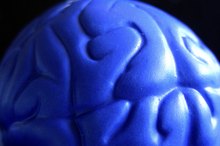Difference Between Human Growth & Development
Human growth is based on biological events that cause you to grow physically that naturally occur during the early stages of your life. Developmental growth, however, is the product of psychological and social growth, emphasized by environmental and individual behavioral factors, sometimes more simply referred to as maturity. While both of these natural processes are vastly different, both growth and development are closely related steps in producing healthy adults.
Human Growth
From early childhood until adolesence, or sometimes early adulthood, growth plates on the ends of long bones, called epiphyseal plates, allow bones to grow. This occurs through osteoclasts and osteoblasts breaking up old bone tissue and rebuilding new bone. It only happens during early human growth and will stop after the epiphyseal plates close. As bone grows, so does tissue and muscle throughout your body. While bone growth ceases early in life, muscles will continue to grow through strength training.
- From early childhood until adolesence, or sometimes early adulthood, growth plates on the ends of long bones, called epiphyseal plates, allow bones to grow.
- This occurs through osteoclasts and osteoblasts breaking up old bone tissue and rebuilding new bone.
Time Frame
Moral Development in Children 6 to 9 Years Old
Learn More
Several psychology and sociology theorists have coined theories of human development. One of the most widely taught theories is Erik Erikson's psychosocial stages of development 1. Just as human growth takes place continually at different rates for children and adolescents, developmental stages follow similar patterns. For instance, children will grow throughout childhood, but one child may grow at a slower rate than another.
Likewise, development will eventually take place in children and adolescents but these stages may come at different rates for different children. A large difference between physical growth and development, however, is that physical growth from bone largely stops at some point. Adults will likely lose and gain weight through fat and muscle growth and loss but will not grow taller after growth plates close. Development continues throughout life, from childhood, adolescence and adulthood, until death.
- Several psychology and sociology theorists have coined theories of human development.
- Likewise, development will eventually take place in children and adolescents but these stages may come at different rates for different children.
Developmentally Challenged
According to Erikson's theory, successful completion of each stage of development is necessary to move on to the next stage of life development. Unfortunately, if a stage of development is never completed, that individual may not complete a healthy life-long development.
For example, in early stages of life, a child learns competence sometime between the ages of six and 12. If this child's competence is hindered for some reason, he may have difficulty graduating to the next developmental stage, which is identity versus role confusion. This adolescent could grow into adulthood feeling inferior and lacking competence, which is often crucial for successful, healthy living.
- According to Erikson's theory, successful completion of each stage of development is necessary to move on to the next stage of life development.
- If this child's competence is hindered for some reason, he may have difficulty graduating to the next developmental stage, which is identity versus role confusion.
Development Stages
When Do Breasts Stop Growing?
Learn More
Early life stages are based on the development of the sense of self. These stages involve trusting others, self control, shame, competence and self faith. As a person progresses from childhood to adulthood, each stage may last for a longer period. For example, the first developmental stage of life, which involves trust and mistrust, lasts from birth until approximately 1 year old. However, the fourth developmental stage of competency and inferiority could last from age 6 to age 12.
- Early life stages are based on the development of the sense of self.
- However, the fourth developmental stage of competency and inferiority could last from age 6 to age 12.
Adulthood Stages
Stages six through eight of human development occur during adulthood. Each of these three stages either occur in early adulthood, mid-adulthood or late adulthood. Early adulthood focuses on intimate relationships outside the family. During this time, you will either commit to long-term relationships or avoid relationships and commitment. Mid-adulthood concentrates on furthering your career and raising families. Late adulthood centers on preparing for the end of life and either embracing this stage or living with regret on the choices made throughout life.
- Stages six through eight of human development occur during adulthood.
- Late adulthood centers on preparing for the end of life and either embracing this stage or living with regret on the choices made throughout life.
Related Articles
References
- SimplyPsychology: Erik Erikson: Erikson Psychosocial Stages of Development
- Kean University: Biomechanics of Human Bone Growth and Development
- Vogel-Scibilia SE, McNulty KC, Baxter B, Miller S, Dine M, Frese FJ. The recovery process utilizing Erikson's stages of human development. Community Ment Health J. 2009;45(6):405-14. doi:10.1007/s10597-009-9189-4
- Malone JC, Liu SR, Vaillant GE, Rentz DM, Waldinger RJ. Midlife Eriksonian psychosocial development: Setting the stage for late-life cognitive and emotional health. Dev Psychol. 2016;52(3):496-508. doi:10.1037/a0039875
- Orenstein GA, Lewis L. Erikson's Stages of Psychosocial Development. In: StatPearls [Internet]. Treasure Island (FL): StatPearls Publishing. Updated March 9, 2020.
- Meeus W, van de Schoot R, Keijsers L, Branje S. Identity statuses as developmental trajectories: A five-wave longitudinal study in early-to-middle and middle-to-late adolescents. J Youth Adolesc. 2012;41(8):1008-1021. doi:10.1007/s10964-011-9730-y
- Fadjukoff P, Pulkkinen L, Kokko K. Identity formation in adulthood: A longitudinal study from age 27 to 50. Identity (Mahwah, N J). 2016;16(1):8-23. doi:10.1080/15283488.2015.1121820
- Carver, CS & Scheir, MF. Perspectives on Personality. Needham Heights, MA: Allyn & Bacon; 2011.
- Erikson, E.H. Childhood and Society. (2nd ed.). New York: Norton; 1993.
- Erikson, EH & Erikson, JM. The Life Cycle Completed. New York: Norton; 1998.








